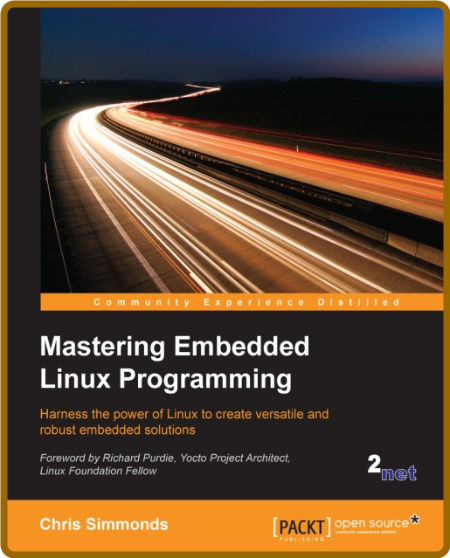
epub | 3.61 MB | English | Isbn: 1789530385 | Author: Frank Vasquez | Year: 2021
Description:
Harness the power of Linux to create versatile and robust embedded solutions
Key Features
[*] Learn how to develop and configure robust embedded Linux devices
[*] Explore the new features of Linux 5.4 and the Yocto Project 3.1 (Dunfell)
[*] Discover different ways to debug and profile your code in both user space and the Linux kernelBook Description
If you're looking for a book that will demystify embedded Linux, then you've come to the right place. Mastering Embedded Linux Programming is a fully comprehensive guide that can serve both as means to learn new things or as a handy reference.
The first few chapters of this book will break down the fundamental elements that underpin all embedded Linux projects: the toolchain, the bootloader, the kernel, and the root filesystem. After that, you will learn how to create each of these elements from scratch and automate the process using Buildroot and the Yocto Project. As you progress, the book will show you how to implement an effective storage strategy for flash memory chips and install updates to a device remotely once it's deployed.
You'll also learn about the key aspects of writing code for embedded Linux, such as how to access hardware from apps, the implications of writing multi-threaded code, and techniques to manage memory in an efficient way. The final chapters demonstrate how to debug your code, whether it resides in apps or in the Linux kernel itself.
You'll also cover the different tracers and profilers that are available for Linux so that you can quickly pinpoint any performance bottlenecks in your system.
By the end of this Linux book, you'll be able to create efficient and secure embedded devices using Linux.What you will learn
[*] Use Buildroot and the Yocto Project to create embedded Linux systems
[*] Troubleshoot BitBake build failures and streamline your Yocto development workflow
[*] Update IoT devices securely in the field using Mender or balena
[*] Prototype peripheral additions by reading schematics, modifying device trees, soldering breakout boards, and probing pins with a logic analyzer
[*] Interact with hardware without having to write kernel device drivers
[*] Divide your system up into services supervised by BusyBox runit
[*] Debug devices remotely using GDB and measure the performance of systems using tools such as perf, ftrace, eBPF, and CallgrindWho this book is for
If you're a systems software engineer or system administrator who wants to learn how to implement Linux on embedded devices, then this book is for you. It's also aimed at embedded systems engineers accustomed to programming for low-power microcontrollers, who can use this book to help make the leap to high-speed systems on chips that can run Linux. Anyone who develops hardware that needs to run Linux will find something useful in this book - but before you get started, you'll need a solid grasp on POSIX standard, C programming, and shell scripting.Table of Contents
[*] Starting Out
[*] Learning about Toolchains
[*] All about Bootloaders
[*] Configuring and Building the Kernel
[*] Building a Root Filesystem
[*] Selecting a Build System
[*] Developing with Yocto
[*] Yocto Under the Hood
[*] Creating a Storage Strategy
[*] Updating Software in the Field
[*] Interfacing with Device Drivers
[*] Prototyping with Breakout Boards
[*] Starting Up - The init Program
[*] Starting with BusyBox runit
[*] Managing Power
[*] Packaging Python
[*] Learning about Processes and Threads
[*] Managing Memory
[*] Debugging with GDB
[*] Profiling and Tracing
[*] Real-Time Programming
Category:Computer Hardware Embedded Systems, Linux & UNIX Administration
download скачать from RapidGator
download скачать from NitroFlare

